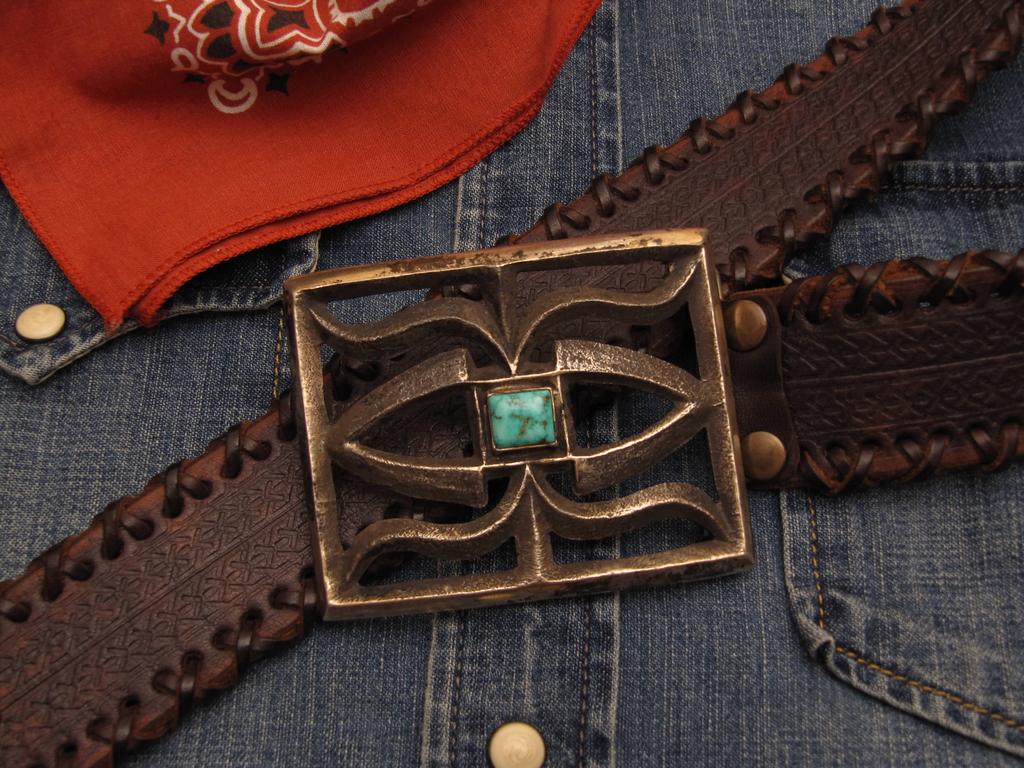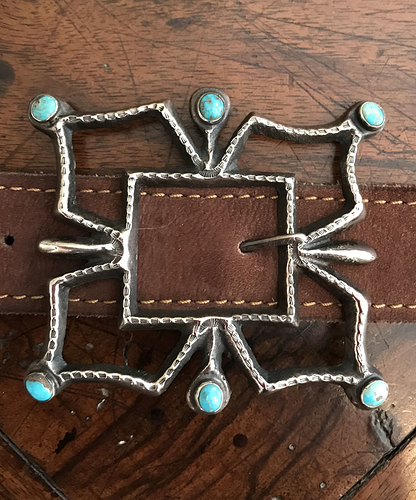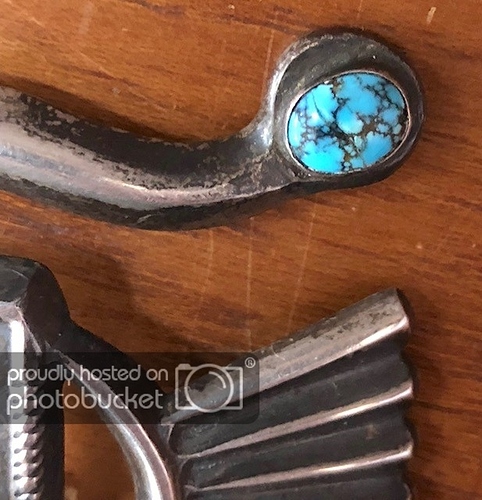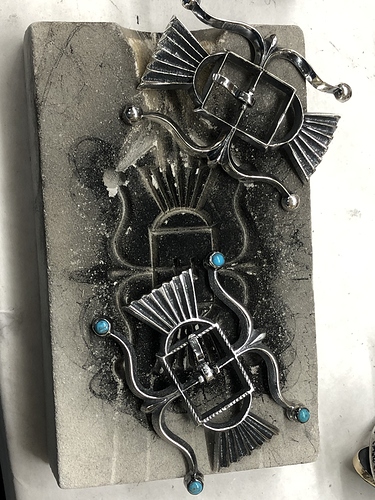Wow. I just joined and glad I did. Great info. And ditto what a beautiful buckle!
I recently got two cast bracelets off eBay from Australia that were obviously made from the same mold, one with turquoise and one beautifully simple and plain. The signatures are different and wondered about that. Will post signatures for you all at some point as the personal connection to the artists is important for me.
If one spends any amount of time looking at sandcast, there are indeed several designs that look sandcast, are sold as unique sandcast, but are duplicated again and again.
BTW I’ve never seen a duplicate of my own sandcast buckle, which I bought off the Rez (NE part of the Checkerboard) in the early Seventies.
This is a terrific site. Thanks, everybody.
Thanks to this excellent video by Gary Custer (Tufa & Sand Casting Featuring Gary Custer - YouTube), I understand the difference between tufa-casting and sandcasting. It also explains why I see the same designs over and over in belt buckles. I understand that an original tufa-cast mold is only good for 1-2 castings and the original tufa-cast piece might be used as a “model or template” for future sandcastings.
So, is it possible to tell if a specific piece came from a tufa-cast mold or a sandcast mold? Are there any characteristics that point to one or the other?
Again, I have studied hundreds of cast buckles and most of them have exact duplicates - give or take added embellishments (i.e. stones, stamp work, etc.) The buckle in my photo below seems to be a little more unique. I have never seen another one just like it with the exact same design. I’m not saying it is a one-of-a-kind or suggesting that it is more important than it is, but it does make me wonder if this buckle is a tufa-cast piece. Any thoughts?
Jason,
Bringing this back to the top. Really curious if there is anyway to tell if a piece is tufa-cast or sandcast?
Thank you!
No. You are going to use artist then price as your best guide. I know when I am getting a piece from Carole Begay that she has used some type of reusable mold, unless it is a new design. However, that new design will then be repeated. When I get a piece from Aaron Anderson and he gives me the mold I know it is a one time piece. I will see other work similar by him but they are originals. Carole and Aaron have different prices that are reflected in this one or multiple pour.
Thanks Jason. So, it sounds like there is no way to tell the difference (visually) if a vintage piece was tufa-cast and sandcast.
I know nothing about metal casting. I would guess with lots of hands on experience there would be ways to recognize the differences. Listened to this vid the other day where the artist referred to his sandstone work as “sand casting”. I wonder (who wrote the book of love lol) if this is common terminology in the trade.
After reading the description of the following sandcast buckle, I discovered an interesting feature that I believe would apply to one of my buckles as well. It is a feature that I never thought about or noticed before.
“Navajo, circa 1940-50’s. Note the bezels for the stones are part of the original cast, so it took a lot of skill to create this buckle.”
My buckle with the same integral bezels…
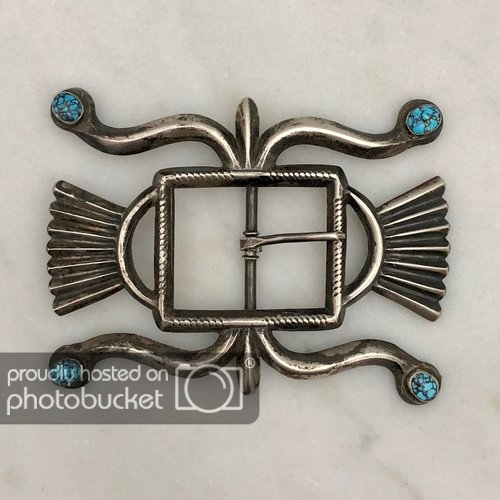
How in the world did the silversmith do this and is this design technique still used today?
I would think the bezel was cast and then the setting was finished by hand.
Yes, I agree, but how did the silversmith incorporate/create the thin bezels on the tips as part of the cast? It seems soldering the bezels on the tips would have been much easier. Really is amazing work.
Yes - really amazing : ) Is it possible he/she did solder the bezel into place and then finished it with fine workmanship? Now you have me curious lol.
Fair question, but the dealer who wrote the description has pretty strong credentials and experience: Link
I missed that we already Know it’s completely cast. I hope some of the silversmiths can answer the question without giving away some trade secrets.  Possibly the bezel was heated, stone was then set and snugged in before metal cooled. Better bow out now as I know nothing about metalsmithing.
Possibly the bezel was heated, stone was then set and snugged in before metal cooled. Better bow out now as I know nothing about metalsmithing.
Thanks for your thoughts, singing. Perhaps Jason will chime in and give us some insight. 
Thanks for the link. Have been browsing around there today and it’s an interesting site. You were not kidding about credentials. I had not found them before and it’s nice knowing they are on the web.
Both Aaron Anderson and Darryl Dean Begay will carve the stone setting in some of their pieces. It can be very difficult to get the silver to flow into all the parts of the carving, especially when you add these little extras. The buckles we are looking at are sandcast pieces, so likely the artist has a template and creates a packed sand mold or a cement mold. It is unlikely that those settings are part of the cast. That is something that you would have carved for one pouring, not multiply. Plus, you are not going to have the same size stones each time. If it was one carving we would probably see the width of the ends match the stone size. It would look solid instead of a small stone on a larger platform. Hope that made sense.
I showed this to Aaron. He said those ends would have been round and they used a tool to flatten and then sanded it to make it flat to put the stones. He is going to make one with the settings carved to see the difference.
Thanks Jason and please thank Aaron for his input as well.
Knowing that the bezels on both buckles above have been soldered on, I must say that the smith did a great job of hiding the transition and making it look like one piece.
Really cool that he tried. I have learned from this entire post. Thanks everyone.
Can’t believe Aaron whipped out those buckles so quickly. That was a lot of work for an experiment. 
